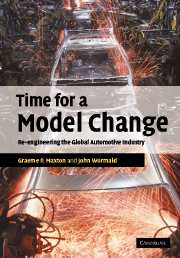Book contents
- Frontmatter
- Contents
- List of figures
- Foreword by G. Fredric Bolling
- Acknowledgements
- Glossary
- Introduction
- 1 From automania to maturity – in the main markets at least
- 2 The problems that can be fixed – dealing with noxious emissions, traffic accidents and congestion
- 3 The global resource challenges – energy and global warming
- 4 A global industry and the changing international order
- 5 The supplier industry – the catalyst for the profound changes to come?
- 6 The downstream sales and service sector
- 7 When the labels do not add up
- 8 Choosing a future for the automotive industry
- 9 Time for a model change
- Index
5 - The supplier industry – the catalyst for the profound changes to come?
Published online by Cambridge University Press: 22 September 2009
- Frontmatter
- Contents
- List of figures
- Foreword by G. Fredric Bolling
- Acknowledgements
- Glossary
- Introduction
- 1 From automania to maturity – in the main markets at least
- 2 The problems that can be fixed – dealing with noxious emissions, traffic accidents and congestion
- 3 The global resource challenges – energy and global warming
- 4 A global industry and the changing international order
- 5 The supplier industry – the catalyst for the profound changes to come?
- 6 The downstream sales and service sector
- 7 When the labels do not add up
- 8 Choosing a future for the automotive industry
- 9 Time for a model change
- Index
Summary
No easy task – the complexities of developing and producing vehicles
Automobiles are complex products. They are complex to design and develop because so many functions are incorporated. They must function together as perfectly and as reliably as possible.
The major subsystems of a car are the body, the chassis, the driveline, the electrical power subsystem, and the command, control and communication subsystem, shown in figure 5.1. Each subsystem divides into a set of functional areas, i.e.:
The body subsystem divides into: bodyshell (the fixed superstructure of the vehicle), doors and latches, internal trim and climate control.
The chassis subsystem divides into: platform (the underpinnings of the vehicle) and corners (the vehicle's links to the road).
The driveline subsystem divides into: engine and transmission (the means whereby the engine's power is delivered to the driving wheels).
Each functional area further subdivides into a set of specific functions, for example:
The corner function contains the running gear (wheels, tyres, wheel bearings, suspension), braking and steering functions.
The engine function contains the short block (cylinder block, cylinder head and all the mechanical moving parts), and the fuelling, de-pollution and cooling systems.
Each specific function is assembled from a set of individual components, for example:
Seating contains frames (which give the seats their strength); foam (which makes them comfortable to sit on for long periods); covers (which make them attractive and practical); and mechanisms (which allow them to be adjusted to the size and shape of particular drivers and reclined.
[…]
- Type
- Chapter
- Information
- Time for a Model ChangeRe-engineering the Global Automotive Industry, pp. 137 - 163Publisher: Cambridge University PressPrint publication year: 2004



